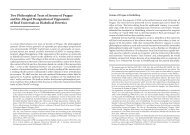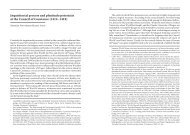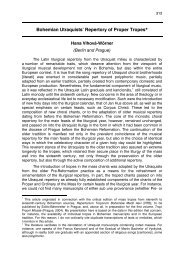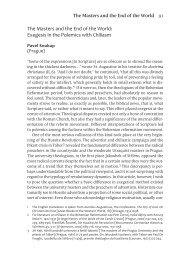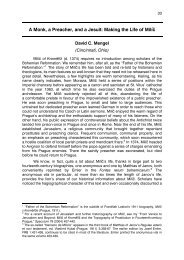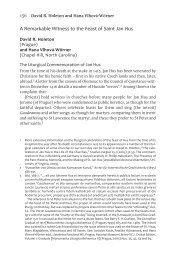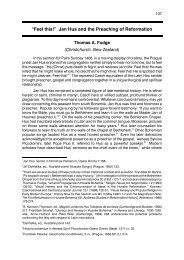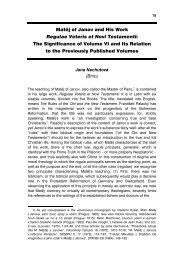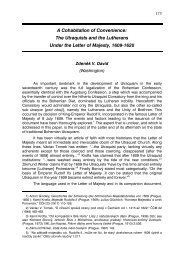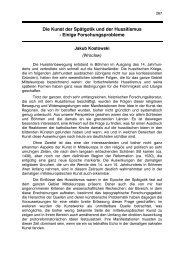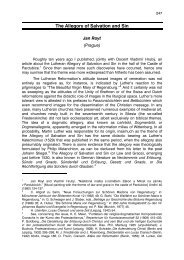quod mulieres, que sunt in Christo, in hoc - Bohemian Reformation ...
quod mulieres, que sunt in Christo, in hoc - Bohemian Reformation ...
quod mulieres, que sunt in Christo, in hoc - Bohemian Reformation ...
Create successful ePaper yourself
Turn your PDF publications into a flip-book with our unique Google optimized e-Paper software.
96<br />
many an evil. The Apostle says: A widow enjoy<strong>in</strong>g luxury, although still liv<strong>in</strong>g, had<br />
already died. The toil<strong>in</strong>g masses do not succumb so easily to s<strong>in</strong>…” 110<br />
Although Želivský did not prepare a systematic disquisition on marriage, his<br />
op<strong>in</strong>ion about the superior status of the husband, as the family’s head, was clearly<br />
on record: “All must listen to the word of God so that the greater may teach the<br />
lesser, and so that every paterfamilias could control his family.” 111<br />
Only the Virg<strong>in</strong> Mary, accord<strong>in</strong>g to the fiery preacher, merited the status of<br />
election and sanctity. She was entitled to the primacy among all women also<br />
because she had followed Christ <strong>in</strong> the fullness of the poverty and humility of his<br />
life. 112 Želivský did not concede to other women the right to sanctity, based on a<br />
div<strong>in</strong>e election. His demonstrated his attitude <strong>in</strong> that regard by discredit<strong>in</strong>g the hoary<br />
tradition of female primacy <strong>in</strong> witness<strong>in</strong>g Christ’s resurrection. In do<strong>in</strong>g so, he took<br />
considerable liberties with the Gospel account. Accord<strong>in</strong>g to his version, while Christ<br />
appeared to the male disciples under his own visage, his epiphany to Mary<br />
Magdalene was <strong>in</strong> the form of a gardener, because this disguise was “suitable for<br />
such novices as Mary Magdalene, who needed to uproot evil and to plant good<br />
seeds.…” 113 In this connection, Želivský did not cite exactly the words of St. John’s<br />
Gospel, where it stands: “When she had said this, she turned around and saw Jesus<br />
stand<strong>in</strong>g there, but she did not know that it was Jesus. Jesus said to her, ‘Woman<br />
why are you weep<strong>in</strong>g ? Whom are you look<strong>in</strong>g for?’ Suppos<strong>in</strong>g he was a gardener,<br />
she said to him.…” 114 Želivský transformed what was an erroneous assumption <strong>in</strong>to<br />
a statement of fact so that he might ga<strong>in</strong> an open<strong>in</strong>g to connect Mary Magdalene<br />
with a reference to evil. Ultimately, he crowned his anti-fem<strong>in</strong><strong>in</strong>e campaign with an<br />
assertion of women’s neglect of Jesus. 115 In dist<strong>in</strong>ction from Waldhauser, Janov,<br />
Štítný, and Hus, the radical preacher of Prague did not see the women’s early<br />
witness of Christ’s resurrection as a matter of privilege and election but, on the<br />
contrary, accused them on that occasion of negligence whereby they had set a bad<br />
example for other Christians.<br />
Contrary to church fathers and other writers of the <strong>Bohemian</strong> <strong>Reformation</strong>, the<br />
militant populist of Prague held that only Our Lady enjoyed her rights and primacy by<br />
virtue of be<strong>in</strong>g a virg<strong>in</strong>. In agreement with Jakoubek, Želivský did not value virg<strong>in</strong>ity<br />
very highly. For reasons of religious politics he was particularly critical of the nuns<br />
110 Jan Želivský, Výzva: Výbor z kázání, ed. Amedeo Molnár (Prague, 1954) 77-78; idem, Dochovaná<br />
kázání 37: “Quia quilibet cristianus debet victum <strong>que</strong>rere ex labore.…Quia qui non laborant, non<br />
manducent. Sic omnes volunt esse curienses, ut ociarentur clientes et virg<strong>in</strong>es et sacerdotes dotati,<br />
altariste canonici. Ex quo <strong>mulieres</strong> ociantes ad multa mala <strong>in</strong>cidunt…Quia laborantes non ita cito<br />
cadent <strong>in</strong> peccata….”<br />
111 Ms. NK Prague V. G. 3, f. 2 a .<br />
112 Ibid. f. 92 a : “Tales <strong>sunt</strong> beati, qui <strong>hoc</strong> vident, sicut…Maria Virgo eum videbat et tangebat et<br />
gaudebat.…;” f. 93 b : “ Quia non solum <strong>sunt</strong> oculi beati, qui viderunt Cristum, ymmo si viderimus<br />
beatam Virg<strong>in</strong>em vel sanctum Petrum, qui viderunt Cristum et amaverunt eum se<strong>que</strong>ndo eum <strong>in</strong> vita<br />
sua pauperrima, humillima, abiectissima…;” f. 145 a : “Maria virgo <strong>in</strong>ter omes <strong>mulieres</strong> pr<strong>in</strong>cipatum<br />
tenet…”<br />
113 Želivskv, Dochovaná kázání 27: “Sed undecim apparuit <strong>in</strong> forma propria, Magdalene <strong>in</strong> forma<br />
ortulani. Forma ortulani ad <strong>in</strong>cipientes pert<strong>in</strong>et, qui debent erradicare mala et plantare bona, sicut<br />
Magdalena.” For Czech translation see Želivský, Výzva 38.<br />
114 Jn 20:14-15.<br />
115 Želivský, Dochovaná kázání 16: “Quia videntes eum pridie mortuum, putabant <strong>in</strong> monimento, <strong>que</strong>m<br />
propter tradicionem seniorum neglexerunt…Sic nunc multi propter tradiciones et mandata hom<strong>in</strong>um<br />
negligunt Cristum.…”



